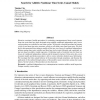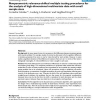100
Voted
JAIR
2006
15 years 16 days ago
2006
Resolution is the rule of inference at the basis of most procedures for automated reasoning. In these procedures, the input formula is first translated into an equisatisfiable for...
118
click to vote
JMLR
2008
15 years 16 days ago
2008
Pointwise consistent, feasible procedures for estimating contemporaneous linear causal structure from time series data have been developed using multiple conditional independence ...
100
click to vote
EOR
2006
15 years 17 days ago
2006
Flexibility and automation in assembly lines can be achieved by the use of robots. The robotic assembly line balancing (RALB) problem is defined for robotic assembly line, where d...
ENTCS
2006
15 years 17 days ago
2006
In previous work we proposed Linear Programs as a fine grained model for imperative programs, and showed how the model checking procedure used in SLAM can be generalised to a mode...
68
Voted
CSDA
2006
15 years 18 days ago
2006
A two-stage sampling procedure for obtaining an optimal confidence interval for the largest or smallest mean of k independent normal populations is proposed, where the population ...
94
Voted
CSDA
2008
15 years 19 days ago
2008
In this paper we use a general procedure for fractional integration and structural breaks at unknown points in time, which allows for different orders of integration and determini...
108
click to vote
BMCBI
2007
15 years 20 days ago
2007
Background: Many procedures for finding differentially expressed genes in microarray data are based on classical or modified t-statistics. Due to multiple testing considerations, ...
136
Voted
BMCBI
2008
15 years 20 days ago
2008
Background: In many research areas it is necessary to find differences between treatment groups with several variables. For example, studies of microarray data seek to find a sign...
98
Voted
BMCBI
2010
15 years 20 days ago
2010
Background: In recent years, gene order data has attracted increasing attention from both biologists and computer scientists as a new type of data for phylogenetic analysis. If ge...
91
Voted
ICASSP
2010
IEEE
15 years 23 days ago
2010
IEEE
In this paper, we explore the use of a Gaussian posteriorgram based representation for unsupervised discovery of speech patterns. Compared with our previous work, the new approach...







